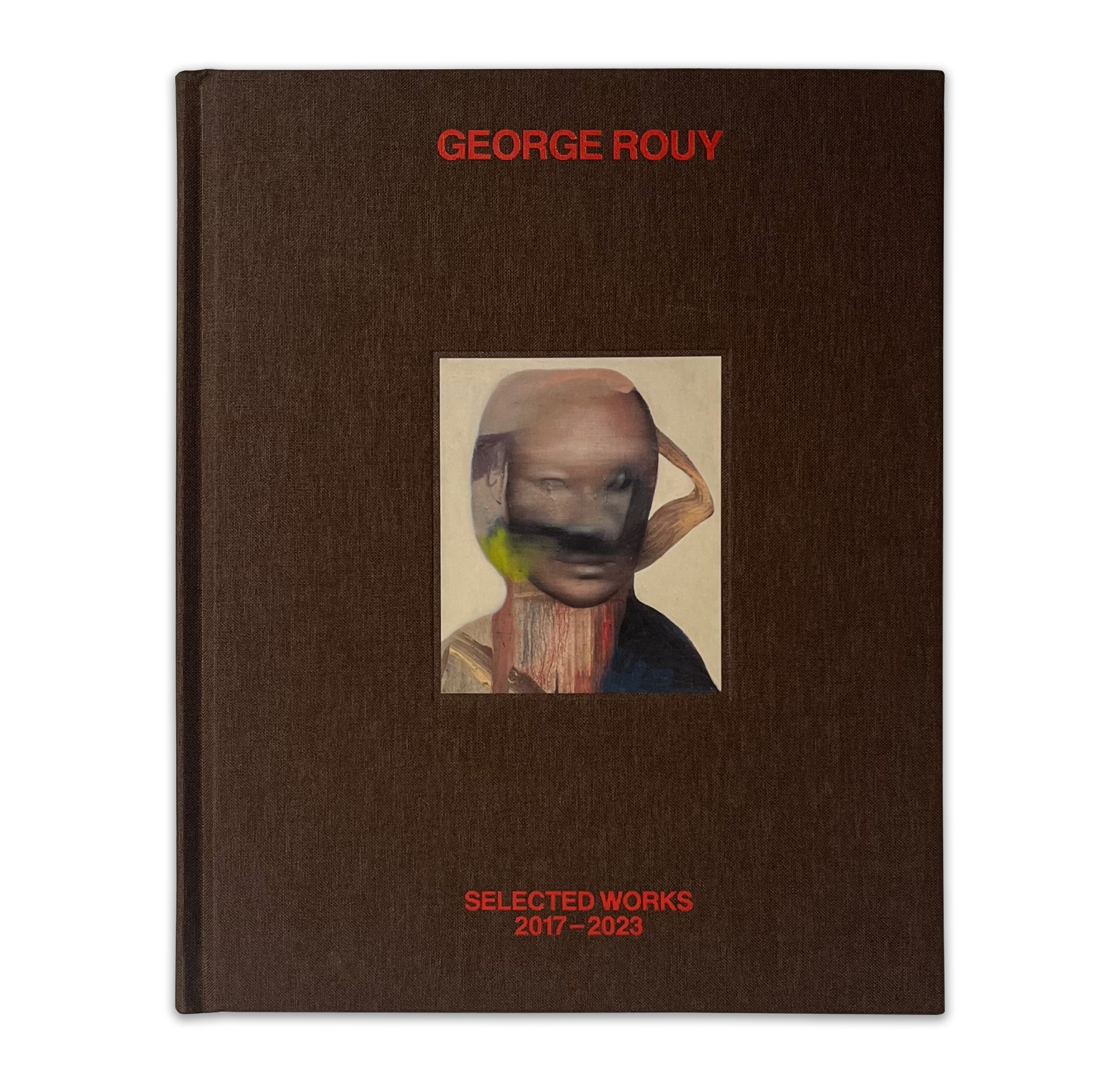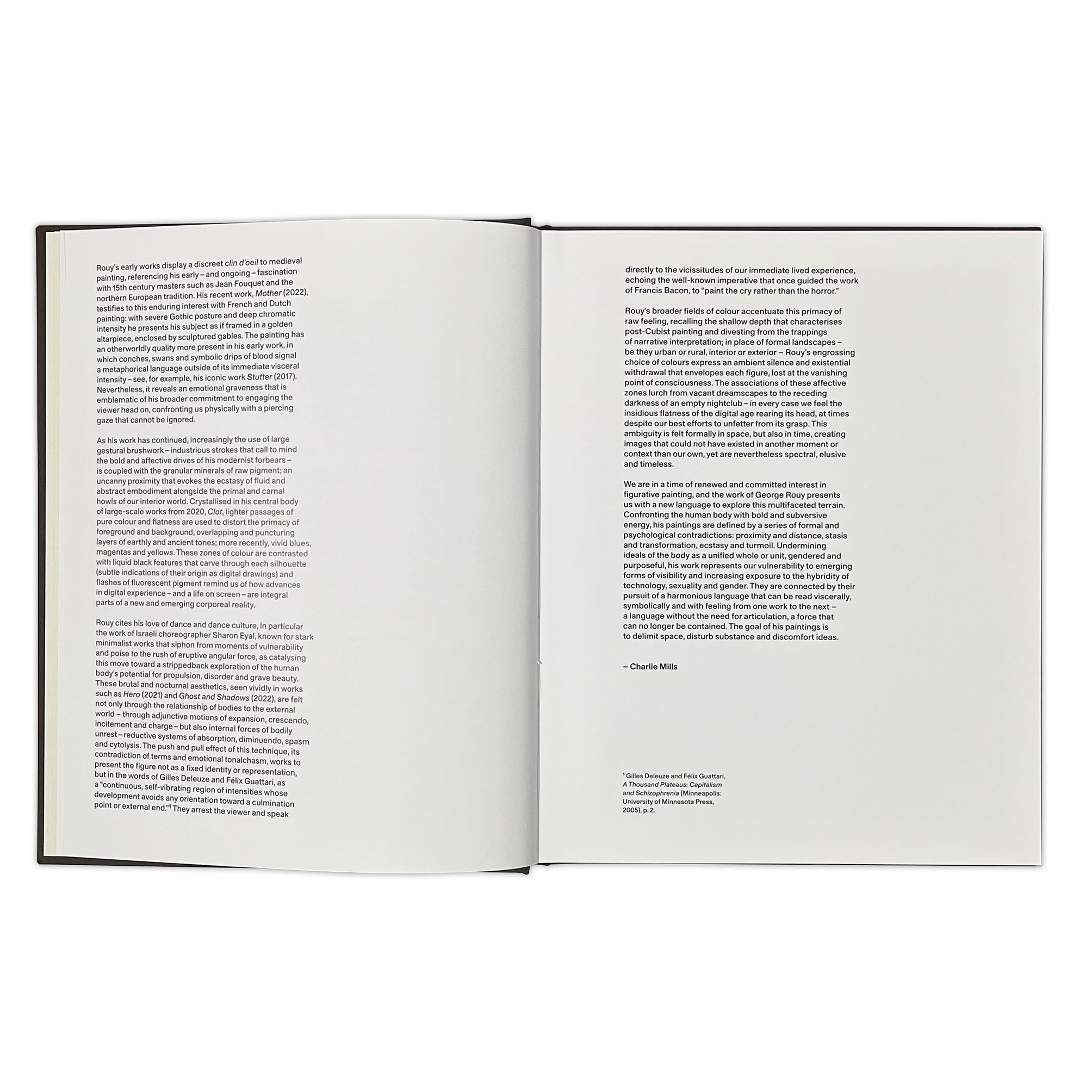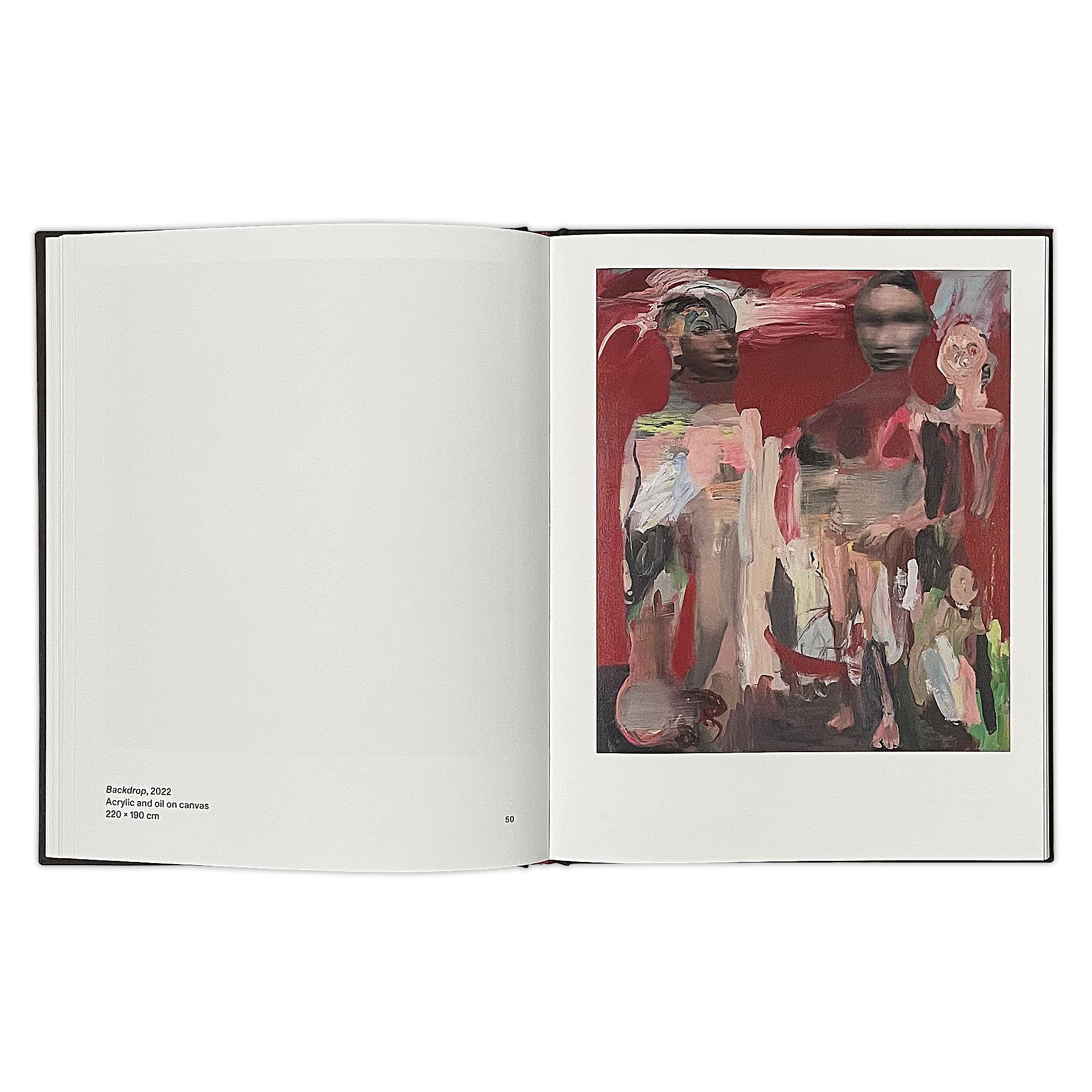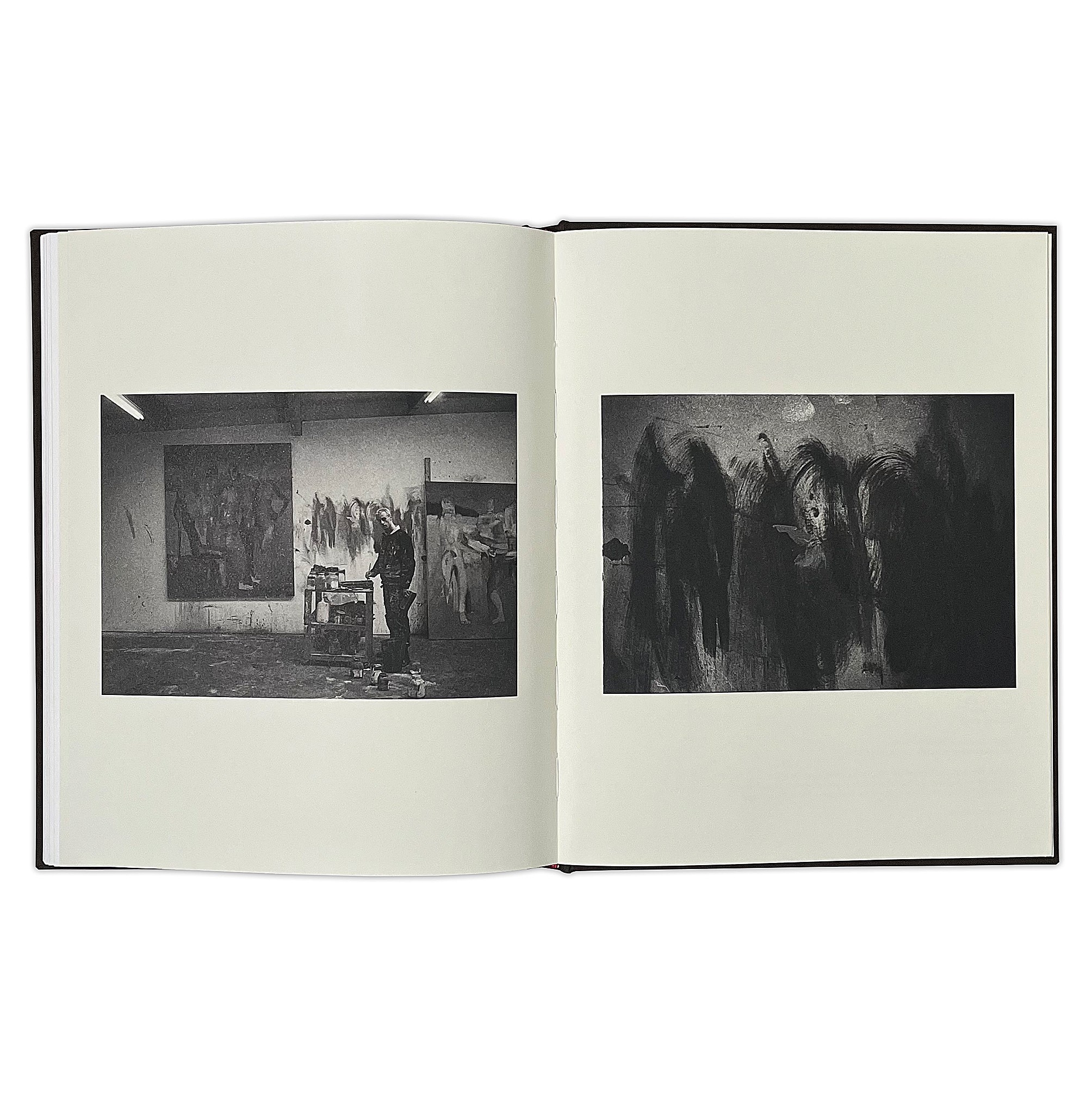Lo Brutto Stahl, Paris & Basel
Exhibition Text
2024
Hannah Barry Gallery x Foolscap Editions, London
Editor
2024
émergent, London
Interview
2024
DUVE, Berlin
Exhibition Text
2024
émergent, London
Interview
2024
Incubator, London
Exhibition Text
2023
QUEERCIRCLE, London
Exhibition Text
2023
L.U.P.O., Milan
Catalogue Essay
2023
Tarmac Press, Herne Bay
Catalogue Essay
2023
Over the past five years, George Rouy has demonstrated his place as a principal figure in a new international generation of figurative painters. Speaking to vexed subjects of human nature – desire, alienation, freedom and crisis – Rouy’s rhapsodic portraits are intense and expressive depictions of identity in a globalised and technologically-driven 21st century. No longer a medium of representation but that of intensity and transmission, Rouy’s style of painting feels as the world does now – slippery, fluid and ruptured. Bodies, captured alone and at times gathered in quiet pairs or imprisoned in crowds of amorphous energy, behave visually as the word does verbally: they secrete, congeal and thicken, pushing the envelope of form and canvas. Drawing from each of us a profound exposure to the fragility of human existence, they evoke the tortuous conflicts at the heart of our contemporary anomie.
Comprising 39 painting created between 2017 – 2022, this inaugural monograph of Rouy’s work, published by Tarmac Press, brings together selected paintings from over ten bodies of work to survey his dynamic and signature use of the human figure, which, constrained and liberated, speaks to the extremities of our time. In the following pages Rouy’s approach shape-shifts from unified, ambient subjects made strange and alluring to us through their sparse yet enduring symbolism – for example, his early paintings from the series Squeeze Hard Enough It Might Just Pop! (2017 - 2018) – to fever dreams of androgynous and gestural forms, charged with lurid flashes of fluorescent pigment. At times figures hoard into crowded, devouring scenes, such as Self Domination in Mass (2019), in which four dark bodies are clutched together as if carved from a single piece of ebony - whilst in others, such as The In Between (2020), they dissolve without sound or warning into the liminal and watery unconscious of a large-scale Rorschach test.
In every case these works present to us the human body in a moment of potential – of collapse, escape, communion, rupture or ecstasy. The titles of Rouy’s exhibitions over this five-year period, and by extension the principal force contained in each body of work, echoes this fascination with the body’s potential for excitation, its drive for extension in space, time and feeling: Leaking Visions of Red, Maelstrom, Rupture and Smothered Awake, to name a few. Together they evoke an accelerating cultural matrix that mixes hyper-speed communications with advanced surveillance technologies, pharmaceutical and cybernetic pleasures with micropolitical forms of discipline and control, the rise of authoritarian politics and reactionary discourses of home and nation with the limitless expression of a life unshackled from the carceral womb of identity.
Rouy’s early works display a discreet clin d’oeil to medieval painting, referencing his early – and ongoing – fascination with 15th century masters such as Jean Fouquet and the northern European tradition. His recent work, Mother (2022), testifies to this enduring interest with French and Dutch painting: with severe Gothic posture and deep chromatic intensity he presents his subject as if framed in a golden altarpiece, enclosed by sculptured gables. The painting has an otherworldly quality more present in his early work, in which conches, swans and symbolic drips of blood signal a metaphorical language outside of its immediate visceral intensity – see, for example, his iconic work Stutter (2017). Nevertheless, it reveals an emotional graveness that is emblematic of his broader commitment to engaging the viewer head on, confronting us physically with a piercing gaze that cannot be ignored.
As his work has continued, increasingly the use of large gestural brushwork – industrious strokes that call to mind the bold and affective drives of his modernist forbears – is coupled with the granular minerals of raw pigment; an uncanny proximity that evokes the ecstasy of fluid and abstract embodiment alongside the primal and carnal howls of our interior world. Crystallised in his central body of large-scale works from 2020, Clot, lighter passages of pure colour and flatness are used to distort the primacy of foreground and background, overlapping and puncturing layers of earthly and ancient tones; more recently, vivid blues, magentas and yellows. These zones of colour are contrasted with liquid black features that carve through each silhouette (subtle indications of their origin as digital drawings) and flashes of fluorescent pigment remind us of how advances in digital experience – and a life on screen – are integral parts of a new and emerging corporeal reality.
Rouy cites his love of dance and dance culture, in particular the work of Israeli choreographer Sharon Eyal, known for stark minimalist works that siphon from moments of vulnerability and poise to the rush of eruptive angular force, as catalysing this move toward a stripped-back exploration of the human body’s potential for propulsion, disorder and grave beauty. These brutal and nocturnal aesthetics, seen vividly in works such as Hero (2021) and Ghost and Shadows (2022), are felt not only through the relationship of bodies to the external world — through adjunctive motions of expansion, crescendo, incitement and charge – but also internal forces of bodily unrest – reductive systems of absorption, diminuendo, spasm and cytolysis. The push and pull effect of this technique, its contradiction of terms and emotional tonal chasm, works to present the figure not as a fixed identity or representation, but in the words of Gilles Deleuze and Félix Guattari, as a “continuous, self-vibrating region of intensities whose development avoids any orientation toward a culmination point or external end.”[1]
They arrest the viewer and speak directly to the vicissitudes of our immediate lived experience, echoing the well-known imperative that once guided the work of Francis Bacon, to “paint the cry rather than the horror.” Rouy’s broader fields of colour accentuate this primacy of raw feeling, recalling the shallow depth that characterises post-Cubist painting and divesting from the trappings of narrative interpretation; in place of formal landscapes – be they urban or rural, interior or exterior – Rouy’s engrossing choice of colours express an ambient silence and existential withdrawal that envelopes each figure, lost at the vanishing point of consciousness. The associations of these affective zones lurch from vacant dreamscapes to the receding darkness of an empty nightclub – in every case we feel the insidious flatness of the digital age rearing its head, at times despite our best efforts to unfetter from its grasp. This ambiguity is felt formally in space, but also in time, creating images that could not have existed in another moment or context than our own, yet are nevertheless spectral, elusive and timeless.
We are in a time of renewed and committed interest in figurative painting, and the work of George Rouy presents us with a new language to explore this multifaceted terrain. Confronting the human body with bold and subversive energy, his paintings are defined by a series of formal and psychological contradictions: proximity and distance, stasis and transformation, ecstasy and turmoil. Undermining ideals of the body as a unified whole or unit, gendered and purposeful, his work represents our vulnerability to emerging forms of visibility and increasing exposure to the hybridity of technology, sexuality and gender. They are connected by their pursuit of a harmonious language that can be read viscerally, symbolically and with feeling from one work to the next – a language without the need for articulation, a force that can no longer be contained. The goal of his paintings is to delimit space, disturb substance and discomfort ideas.
[1] Gilles Deleuze and Félix Guattari, A Thousand Plateaus: Capitalism and Schizophrenia (Minneapolis: University of Minnesota Press,
2005), p. 2.
108 pages
Linen bound hardback with tip-in and foil block cover
Litho print on Magno Volume & Munken Lynx paper
Essay by Charlie Mills
Studio photography by Kingsley Ifill
Designed by Jamie Reid Studio
Published by Tarmac Press 2023
Published on the occasion of the artists solo exhibition BODY SUIT at Hannah Barry Gallery.




Brooke Bennington, London
Exhibition Text
2023
Freelands Foundation, London
Catalogue Essay
2023
superzoom, Paris
Exhibition Text
2023
Lichen Books, London
Catalogue Essay
2022
Tennis Elbow, New York
Exhibition Text
2022
émergent, London
Interview
2022
Guts Gallery, London
Exhibition Text
2021
Kupfer Projects, London
Exhibition Text
2021
Collective Ending, London
Catalogue Essay
2021
L21 Gallery S’Escorxador, Palma De Mallorca
Exhibition Text
2021
TJ Boulting, London
Exhibition Text
2021
Quench Gallery, Margate
Exhibition Text
2021
COEVAL, Berlin
Interview
2021
COEVAL, Berlin
Interview
2021
Foolscap Editions, London
Catalogue Essay
2020
Gentrified Underground, Zurich
Catalogue Essay
2020
Camberwell College of Arts, London
Exhibition Text
2019
Kronos Publishing, London
Editor
2019
Elam Publishing, London
Editor
2019
William Bennington Gallery, London
Catalogue Essay
2019
Elam Publishing, London
Catalogue Essay
2018
Camberwell College of Arts, London
Exhibition Text
2018
Limbo Limbo, London
Exhibition Text
2017
Saatchi Art & Music Magazine, London
Review
2017
B.A.E.S., London
Exhibition Text
2016